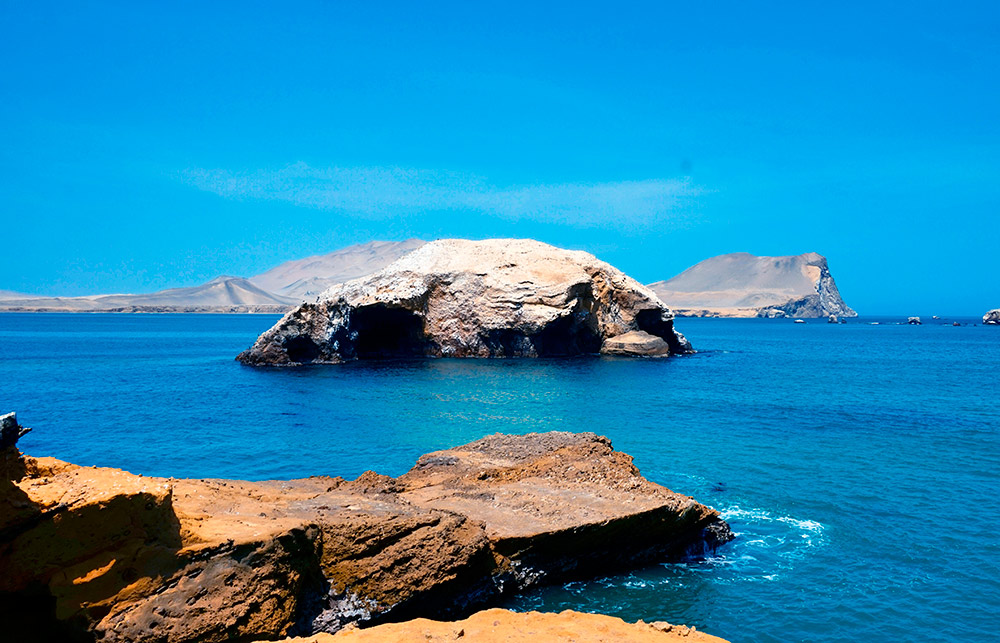位于秘魯的帕拉卡斯國家保護區是全球最大的生態寶庫之一。但如今,這片自然保護區受到了威脅,一群港口管理企業家正盤算著借道此地運輸精礦。帕拉卡斯保護區的命運岌岌可危——它會得到拯救,還是會迎來毀滅?
1975年,秘魯政府成立了帕拉卡斯國家保護區,致力“保護這個獨特生態系統的自然狀態”。帕拉卡斯以其豐富的野生動物資源聞名。這片土地不僅孕育了鯨魚、海獅、海豚,能見到火烈鳥、禿鷹、企鵝等各種奇異的鳥類,還生活著少量瀕臨滅絕的動物,如綠海龜、海獺。

帕拉卡斯保護區不僅是生物多樣性豐富的自然天堂,還保存著帕拉卡斯文化的考古遺產。帕拉卡斯文化是美洲最著名的前哥倫布文明之一,世界上的許多知名博物館都藏有該文明的古代紡織品。這些特色使帕拉卡斯成為了秘魯第二受歡迎的旅游勝地,僅次于庫斯科的馬丘比丘。帕拉卡斯也得到了國際社會的認可:1992年,聯合國根據《國際濕地公約》將帕拉卡斯列為了保護對象。
雖然聽起來有些不可思議,但這個保護區如今正面臨著危險:一家公司聯盟打算通過圣馬丁港運輸出口銅和鋅精礦,并且已經取得了政府授予的港口特許使用權。而圣馬丁港位于帕拉卡斯灣,地處帕拉卡斯保護區的“緩沖帶”。

緩沖帶與保護區相鄰或緊鄰。根據秘魯法律,這些地帶享有特殊待遇,需要遵守特殊限制,以便為周邊的保護區增添額外的保護。然而在2014年,秘魯政府舉行了一場圣馬丁港招標,力圖推進港口現代化,而非盡可能降低港口對緩沖帶的影響。批評人士認為,政府此舉違反了相關法律。
由西班牙Servinoga公司和巴西Pattac公司、Tucumann公司組成的公司聯盟贏得招標,拿到了合同,目前正通過Terminal Portuario Paracas公司(TPP)管理圣馬丁港。其中,Servinoga公司專門從事海運貿易,Pattac公司、Tucumann公司則側重物流運營和港口碼頭。
最初,監管機構對TPP公司的環境影響評估(EIA)提出了多項異議,認為EIA無法證明TPP公司不會對帕拉卡斯保護區造成不可逆的破壞,并因此禁止了圣馬丁港的運營。2016年,佩德羅?巴勃羅?庫琴斯基贏得秘魯總統大選后,雖然TPP公司并未根據此前監管機構提出的異議進行改正調整,但政府依然批準了TPP公司的EIA。兩年后,也就是2018年,TPP公司決定申請修改EIA,以便處理和出口礦產。由于圣馬丁港沒有其他進入通道,這些礦產運輸時必須直接穿過帕拉卡斯保護區。
2019年,秘魯全國可持續投資環境認證服務局(Senace)拒絕了TPP公司的申請,但公司對此提起了上訴。未來幾天,該部門需要就是否批準或拒絕TPP公司的新EIA作出裁決。
TPP公司的新EIA提出要建設一處精礦貯存區。公司聲稱,他們會利用技術避免一切形式的污染,如密封容器、密封卡車和負壓貯存。然而,僅穿行重型車流增加這一項(每年將有多達1.3萬輛滿載精礦石的卡車穿過保護區),就必然會對保護區造成噪音和視覺污染。新EIA也會增加物質污染風險,只要一輛卡車發生事故或翻車,環境就有可能受到污染。事實上,該地區風速高達每小時100公里(每小時62英里),此前就已經出現過類似的事故。而且,銅和鋅精礦對海洋生物具有很高的毒性,一旦泄露進入水中就會造成非常可怕的后果。
不幸的是,即使到了2020年,一些人仍然拒絕理解并非所有地理區域都可以開展工業和采礦活動。事實上,自然保護區就無法開展此類活動。
如果我們想開始保護自然,我們應該號召全世界公民團結起來,更有效地保護我們的自然保護區——無論秘魯、芬蘭還是蘇丹,保護自然沒有國界,也不分國籍。如果說有什么能超越國籍和經濟狀況,把所有人都團結起來,那應該是我們對自然保護區的尊重。這份尊重提醒著我們,人類與自然仍有和平相處的希望和余地。(財富中文網)
曼紐爾?巴特拉是一位常駐秘魯利馬的律師和活動家,同時也為獨立新聞網站La Mula撰寫專欄。
譯者:Shog
位于秘魯的帕拉卡斯國家保護區是全球最大的生態寶庫之一。但如今,這片自然保護區受到了威脅,一群港口管理企業家正盤算著借道此地運輸精礦。帕拉卡斯保護區的命運岌岌可危——它會得到拯救,還是會迎來毀滅?
1975年,秘魯政府成立了帕拉卡斯國家保護區,致力“保護這個獨特生態系統的自然狀態”。帕拉卡斯以其豐富的野生動物資源聞名。這片土地不僅孕育了鯨魚、海獅、海豚,能見到火烈鳥、禿鷹、企鵝等各種奇異的鳥類,還生活著少量瀕臨滅絕的動物,如綠海龜、海獺。
帕拉卡斯保護區不僅是生物多樣性豐富的自然天堂,還保存著帕拉卡斯文化的考古遺產。帕拉卡斯文化是美洲最著名的前哥倫布文明之一,世界上的許多知名博物館都藏有該文明的古代紡織品。這些特色使帕拉卡斯成為了秘魯第二受歡迎的旅游勝地,僅次于庫斯科的馬丘比丘。帕拉卡斯也得到了國際社會的認可:1992年,聯合國根據《國際濕地公約》將帕拉卡斯列為了保護對象。
雖然聽起來有些不可思議,但這個保護區如今正面臨著危險:一家公司聯盟打算通過圣馬丁港運輸出口銅和鋅精礦,并且已經取得了政府授予的港口特許使用權。而圣馬丁港位于帕拉卡斯灣,地處帕拉卡斯保護區的“緩沖帶”。
緩沖帶與保護區相鄰或緊鄰。根據秘魯法律,這些地帶享有特殊待遇,需要遵守特殊限制,以便為周邊的保護區增添額外的保護。然而在2014年,秘魯政府舉行了一場圣馬丁港招標,力圖推進港口現代化,而非盡可能降低港口對緩沖帶的影響。批評人士認為,政府此舉違反了相關法律。
由西班牙Servinoga公司和巴西Pattac公司、Tucumann公司組成的公司聯盟贏得招標,拿到了合同,目前正通過Terminal Portuario Paracas公司(TPP)管理圣馬丁港。其中,Servinoga公司專門從事海運貿易,Pattac公司、Tucumann公司則側重物流運營和港口碼頭。
最初,監管機構對TPP公司的環境影響評估(EIA)提出了多項異議,認為EIA無法證明TPP公司不會對帕拉卡斯保護區造成不可逆的破壞,并因此禁止了圣馬丁港的運營。2016年,佩德羅?巴勃羅?庫琴斯基贏得秘魯總統大選后,雖然TPP公司并未根據此前監管機構提出的異議進行改正調整,但政府依然批準了TPP公司的EIA。兩年后,也就是2018年,TPP公司決定申請修改EIA,以便處理和出口礦產。由于圣馬丁港沒有其他進入通道,這些礦產運輸時必須直接穿過帕拉卡斯保護區。
2019年,秘魯全國可持續投資環境認證服務局(Senace)拒絕了TPP公司的申請,但公司對此提起了上訴。未來幾天,該部門需要就是否批準或拒絕TPP公司的新EIA作出裁決。
TPP公司的新EIA提出要建設一處精礦貯存區。公司聲稱,他們會利用技術避免一切形式的污染,如密封容器、密封卡車和負壓貯存。然而,僅穿行重型車流增加這一項(每年將有多達1.3萬輛滿載精礦石的卡車穿過保護區),就必然會對保護區造成噪音和視覺污染。新EIA也會增加物質污染風險,只要一輛卡車發生事故或翻車,環境就有可能受到污染。事實上,該地區風速高達每小時100公里(每小時62英里),此前就已經出現過類似的事故。而且,銅和鋅精礦對海洋生物具有很高的毒性,一旦泄露進入水中就會造成非常可怕的后果。
不幸的是,即使到了2020年,一些人仍然拒絕理解并非所有地理區域都可以開展工業和采礦活動。事實上,自然保護區就無法開展此類活動。
如果我們想開始保護自然,我們應該號召全世界公民團結起來,更有效地保護我們的自然保護區——無論秘魯、芬蘭還是蘇丹,保護自然沒有國界,也不分國籍。如果說有什么能超越國籍和經濟狀況,把所有人都團結起來,那應該是我們對自然保護區的尊重。這份尊重提醒著我們,人類與自然仍有和平相處的希望和余地。(財富中文網)
曼紐爾?巴特拉是一位常駐秘魯利馬的律師和活動家,同時也為獨立新聞網站La Mula撰寫專欄。
譯者:Shog
Peru’s Paracas National Reserve, one of the world’s greatest ecological treasures, is under threat from a group of port management entrepreneurs who are seeking to transport ore concentrate through this protected natural area. The fate of the Paracas Reserve—its salvation or imminent destruction—is at stake.
In 1975, the Peruvian government established the Paracas National Reserve in an effort to “conserve the natural state” of this one-of-a-kind ecosystem. Paracas is known for its wealth of wild fauna, including whales, sea lions, dolphins, and a variety of exotic birds such as flamingos, condors, and penguins, as well as for a handful of animals in danger of extinction, including the green sea turtle and the sea otter.
But the Paracas Reserve is not just a natural paradise in terms of biological diversity. It also protects the archaeological heritage of one of the Americas’ most noted pre-Columbian cultures, the Paracas, whose ancient textiles are on display in many of the world’s most famous museums. This range of features has made Paracas the second-most-popular tourist destination in Peru, behind only Machu Picchu in Cuzco. The Paracas is also recognized by the international community: In 1992, the United Nations designated Paracas for protection under the international convention on wetlands.
As incomprehensible as it may seem, the reserve is now in danger because of a consortium’s intention to transport and export copper and zinc concentrates via the Port of San Martín. This port, located on the Bay of Paracas in the reserve’s “buffer zone,” has been awarded by the national government in concession to the consortium.
A buffer zone is the space neighboring or immediately contiguous to the protected area. By Peruvian law, these zones are subject to special treatment and restrictions in order to provide an additional layer of protection to the areas they surround. However, in what critics argue is a violation of these laws, the Peruvian government carried out a tender process in 2014 for the Port of San Martín with the goal of modernizing it, rather than keeping its impact to a bare minimum.
In this tender process, the contract was awarded to a consortium consisting of the Spanish company Servinoga, which specializes in maritime trade, and the Brazilian companies Pattac and Tucumann, which focus on logistic operations and port terminals. This consortium currently manages the port via the company Terminal Portuario Paracas (TPP).
The port was initially prevented from operating after regulatory agencies raised multiple objections to TPP’s Environmental Impact Assessment (EIA), which was unable to prove that no irreversible damages would be caused to the Paracas Reserve. After Pedro Pablo Kuczynski won Peru’s presidential election in 2016, the EIA was approved, despite the fact that the objections raised at that time had not been rectified. Two years later, in 2018, TPP decided to request an amendment to its EIA so that it could handle and export minerals, which would have to be transported directly through the Paracas Reserve due to the absence of any other possible way of accessing the port.
In 2019, the Peruvian environmental authority (Senace) rejected the request, but TPP appealed the decision. In the coming days, this authority will be required to issue its ruling on whether or not to approve or reject the new EIA, which includes the construction of an Ore Concentrate Storage Area.
TPP claims that they will use technology that would avoid any kind of pollution (e.g. closed containers, hermetic trucks, and storage with negative pressure). But the mere increase in heavyweight vehicle traffic through the reserve—through which up to 13,000 trucks full of ore concentrate would drive each year—already represents an undeniable source of noise and visual pollution. Greater still is the risk of contamination in the event that one of these trucks is involved in an accident or overturns. Indeed, such cases have already been reported in the zone, where winds blow at speeds of up to 100 kilometers per hour (62 miles per hour). And copper and zinc ore concentrates, when discharged into water, are extremely toxic to marine life—making the potential consequences of a spill very dire.
It is unfortunate that even today, in the year 2020, some people still refuse to understand that industrial and mining activities cannot take place in any and all geographic areas. Indeed, it is precisely places like natural reserves that must represent one of the limits to such activities.
If we want to start protecting nature, whether in Peru, Finland, or Sudan, it is time for the citizens of the world to come together and more effectively defend our natural reserves, which recognize no boundaries or passports. If there is something that unites us, regardless of our nationality or our economic status, it should be our respect for those natural sanctuaries that remind us that there is still hope and room for balance between human beings and nature.
Manuel Bartra is a lawyer and activist based in Lima, Peru. He is also a columnist for the online independent journalism platform La Mula.






